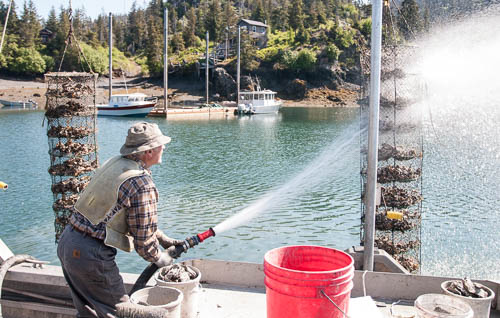Alaska mariculture projects receive federal funding
November 1, 2017
Paula Dobbyn
907-274-9698

Alaska Sea Grant has received funding to help marine aquaculture businesses in the state find good locations, obtain geoduck seeds and avoid shutdowns after heavy rains.
The three Alaska projects received about $400,000 out of $9.3 million awarded nationally to aquaculture projects by Sea Grant, part of the National Oceanic and Atmospheric Administration.
“This award will help Alaska move forward with developing a strong and sustainable mariculture industry in our waters," said Ginny Eckert, Alaska Sea Grant's associate director for research.
Alaska Sea Grant, a partnership between NOAA and the University of Alaska Fairbanks College of Fisheries and Ocean Sciences, will award the funding to three nonprofit organizations to conduct the research:
- The Alaska Fisheries Development Foundation, using a $140,000 grant, will develop a geographic information system tool to help investors identify appropriate mariculture sites in Alaska, using methods developed in Maine. The grant provides about $140,000.
- OceansAlaska , with $150,000, will develop geoduck seeds for farmers, who are constrained by inconsistent supply. The project aims to improve geoduck spawning and increase knowledge of hatchery procedures.
- Pacific Shellfish Institute, with $95,000, will study the relationship between rainfall and water quality in remote areas. Heavy rain can wash coliform bacteria into the ocean near shellfish growing operations, prompting closures. However, shellfish grow several feet underwater, where coliform concentrations may be lower. “The research and data will help determine if these closures are justified,” said Gary Freitag, Alaska Sea Grant’s Marine Advisory agent in Ketchikan.
"The Alaska projects originated within the industry and are in partnership with Alaska Sea Grant," Eckert said. "This research will help to expand an industry that presents a new economic opportunity for our state, particularly coastal communities."
Since 1988 when Alaska lawmakers gave their approval, the industry has grown from a single farmer to some 65 aquatic farms, seven shellfish nurseries and two shellfish hatcheries. It’s considered a bright spot in Alaska’s struggling, oil-dependent economy.
In 2014, Alaska’s aquatic farm industry generated over $1 million in sales, a 27 percent increase over the prior year, according to the Alaska Department of Fish and Game.
NOTE TO EDITORS: Images and video are available for download at http://aquaculture.seagrant.uaf.edu/


